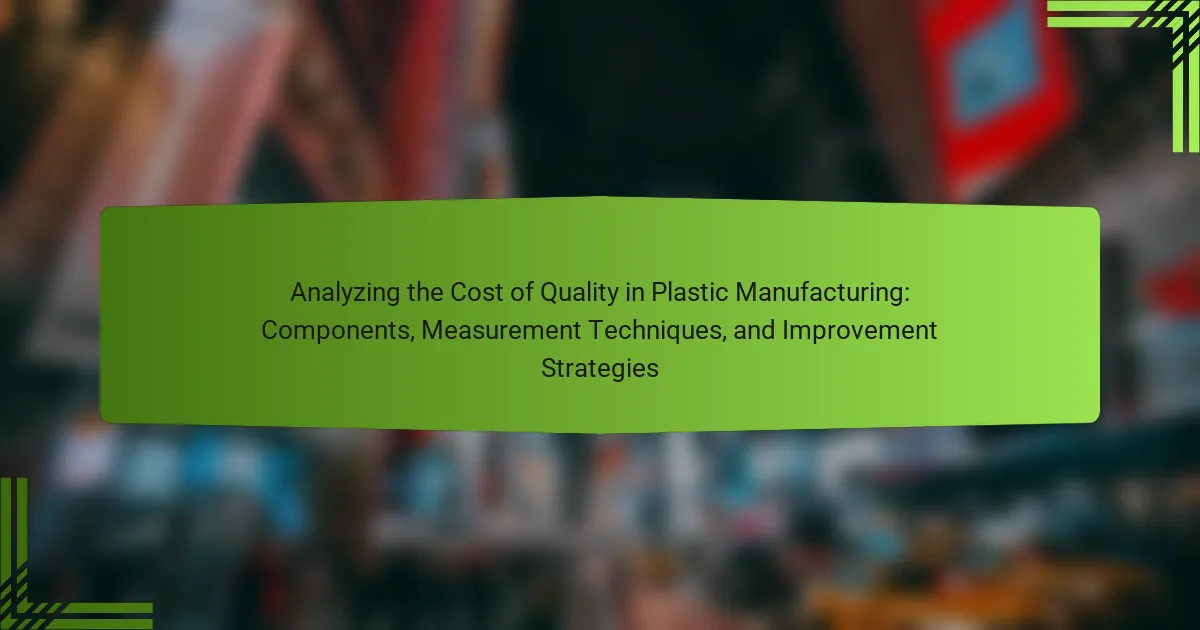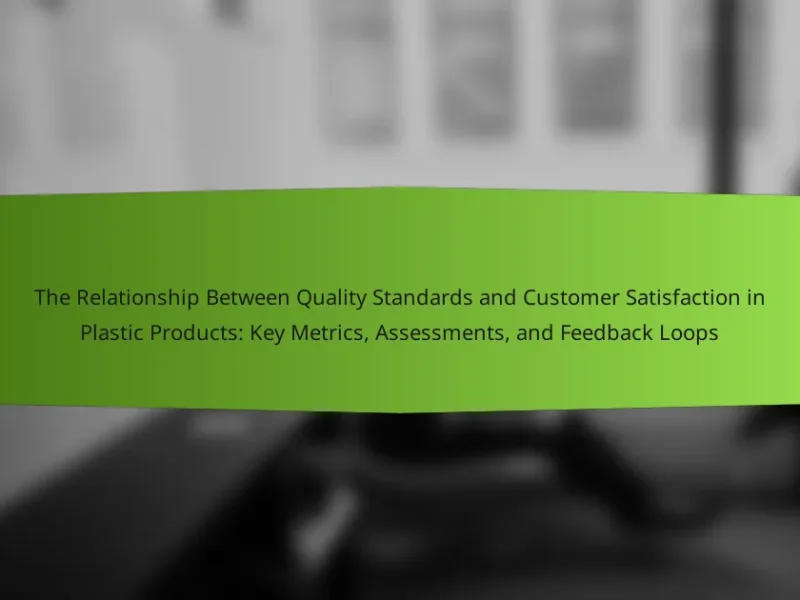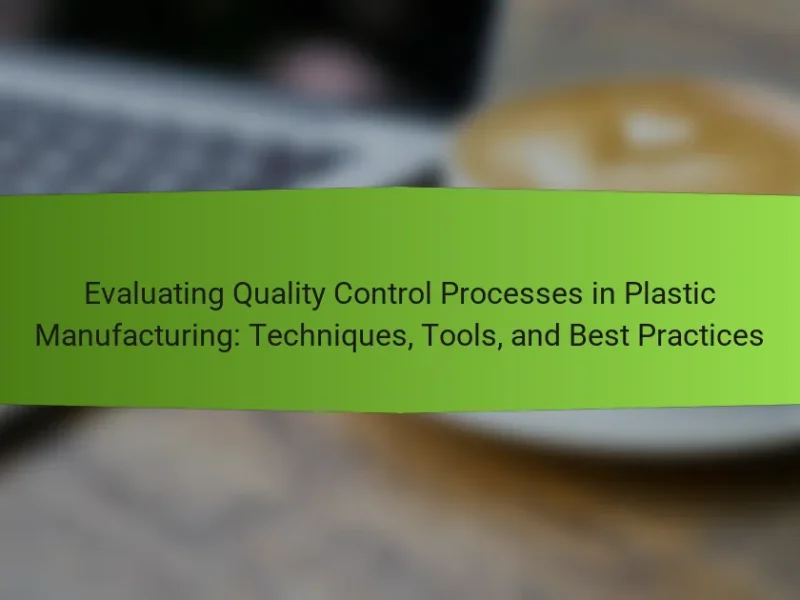The Cost of Quality in plastic manufacturing encompasses the total expenses involved in ensuring products meet established quality standards, including prevention, appraisal, and failure costs. Key components of this cost include prevention costs related to training and process control, appraisal costs for inspection and testing, internal failure costs arising from defects found before delivery, and external failure costs linked to defects discovered post-delivery. Effective measurement of these components is crucial for identifying improvement areas and reducing costs. Strategies to enhance the Cost of Quality involve employee training, implementing robust quality management systems, utilizing statistical process control, conducting regular audits, and engaging suppliers in quality initiatives. These approaches collectively aim to improve production efficiency and lower costs associated with quality failures.
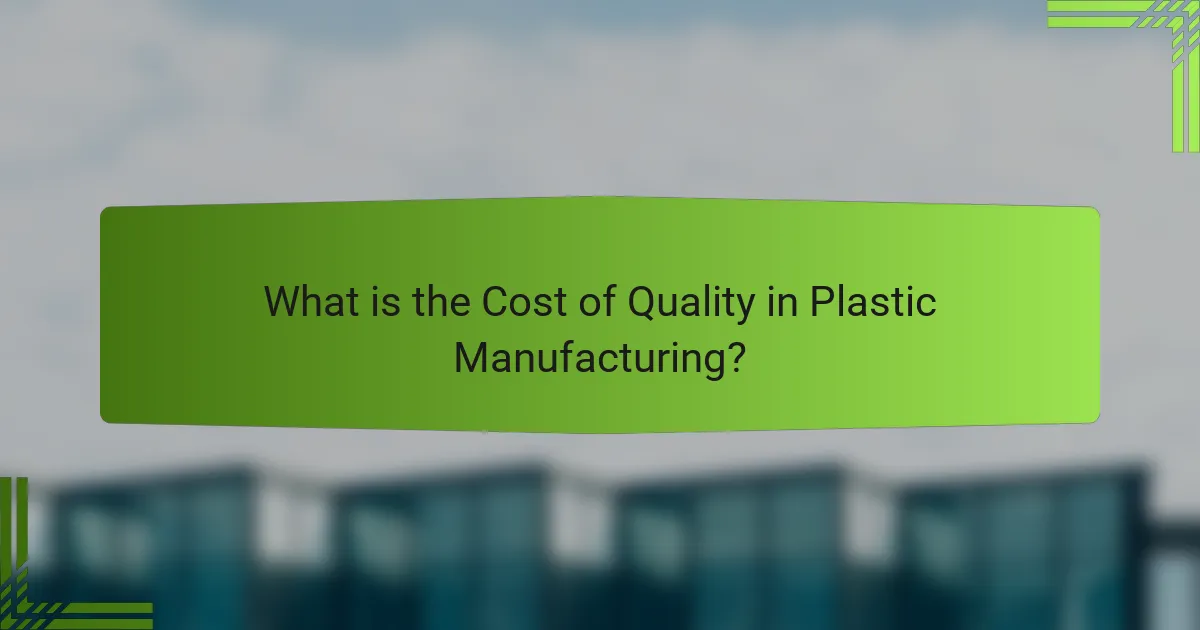
What is the Cost of Quality in Plastic Manufacturing?
The Cost of Quality in plastic manufacturing refers to the total costs associated with ensuring that products meet quality standards. This includes prevention costs, appraisal costs, and failure costs. Prevention costs involve expenses related to activities aimed at preventing defects, such as training and process control. Appraisal costs are incurred during the inspection and testing of products to ensure they meet specifications. Failure costs arise when products fail to meet quality standards, leading to rework, scrap, and warranty claims. According to a study by the American Society for Quality, poor quality can account for 20-30% of total production costs in manufacturing. This highlights the significance of managing quality to reduce overall costs.
Why is understanding the Cost of Quality important in plastic manufacturing?
Understanding the Cost of Quality is crucial in plastic manufacturing because it directly impacts profitability and product reliability. The Cost of Quality encompasses all costs associated with ensuring that products meet quality standards. This includes prevention costs, appraisal costs, and failure costs. By analyzing these costs, manufacturers can identify areas for improvement. Reducing failure costs, for example, can lead to significant savings. Studies show that companies prioritizing quality often experience lower defect rates and higher customer satisfaction. A focus on the Cost of Quality can enhance operational efficiency and drive competitive advantage in the market.
What are the key components of the Cost of Quality?
The key components of the Cost of Quality are prevention costs, appraisal costs, internal failure costs, and external failure costs. Prevention costs include expenses related to activities designed to prevent defects. This may involve training, process control, and quality planning. Appraisal costs are incurred to evaluate and measure products or services. These costs cover inspections, testing, and audits.
Internal failure costs arise when defects are found before products reach the customer. This includes rework, scrap, and downtime. External failure costs occur when defects are discovered after delivery to the customer. This can lead to warranty claims, returns, and loss of reputation. Understanding these components helps organizations improve quality and reduce overall costs.
How does the Cost of Quality impact overall manufacturing efficiency?
The Cost of Quality (CoQ) significantly impacts overall manufacturing efficiency by influencing production processes and resource allocation. High CoQ indicates increased expenses related to defects, rework, and inspections. This can lead to reduced output and longer production times. According to the American Society for Quality, poor quality costs can account for up to 30% of a company’s revenue.
Increased CoQ often results in diminished operational efficiency. Manufacturers may face delays and increased labor costs due to rework and waste. Conversely, reducing CoQ through proactive quality management can enhance efficiency. This can lead to faster production cycles and lower operational costs. Companies that invest in quality improvement initiatives often see a return on investment through enhanced productivity and reduced waste.
In summary, managing CoQ effectively can lead to improved manufacturing efficiency by minimizing defects and optimizing resource use.
What are the different types of costs associated with quality in plastic manufacturing?
The different types of costs associated with quality in plastic manufacturing include prevention costs, appraisal costs, internal failure costs, and external failure costs. Prevention costs are expenses incurred to prevent defects and ensure quality, such as training and quality planning. Appraisal costs involve expenses related to measuring and monitoring quality, including inspection and testing. Internal failure costs arise from defects found before products are shipped, leading to rework and scrap. External failure costs occur when defects are discovered after delivery, resulting in warranty claims and returns. Each of these cost categories impacts overall production efficiency and profitability.
What are prevention costs, and why are they essential?
Prevention costs are expenses incurred to prevent defects and ensure quality in manufacturing processes. These costs include training, quality planning, and process control measures. They are essential because they help reduce the likelihood of defects, which can lead to higher costs later in production. Investing in prevention costs can lead to significant savings by minimizing rework and scrap rates. Research shows that companies focusing on prevention experience lower overall costs and improved product quality. For instance, a study by the American Society for Quality indicates that investing in quality improvements can yield a return on investment of up to 10 times.
How do appraisal costs contribute to quality management?
Appraisal costs contribute to quality management by ensuring that products meet quality standards before they reach the customer. These costs include expenses related to inspections, testing, and quality audits. By investing in appraisal activities, manufacturers can identify defects early in the production process. This proactive approach reduces the likelihood of costly recalls or customer complaints. Studies show that effective appraisal processes can decrease overall production costs by minimizing waste and rework. For example, implementing regular quality checks can lead to a 30% reduction in defect rates. Thus, appraisal costs play a crucial role in maintaining high-quality standards and enhancing customer satisfaction.
What are the implications of internal and external failure costs?
Internal and external failure costs significantly impact overall quality management. Internal failure costs arise from defects found before products reach customers. They include rework, scrap, and downtime. These costs indicate inefficiencies in the production process. Reducing internal failure costs can enhance productivity and profitability.
External failure costs occur when defects are discovered after delivery. They encompass warranty claims, returns, and customer complaints. These costs can harm brand reputation and customer loyalty. High external failure costs often lead to lost sales and increased marketing expenses to regain customer trust.
Both types of failure costs highlight the importance of quality control. Effective quality management systems can minimize these costs. According to the American Society for Quality, organizations can save up to 20% of their operating costs by improving quality. Thus, addressing both internal and external failure costs is crucial for sustainable business success.
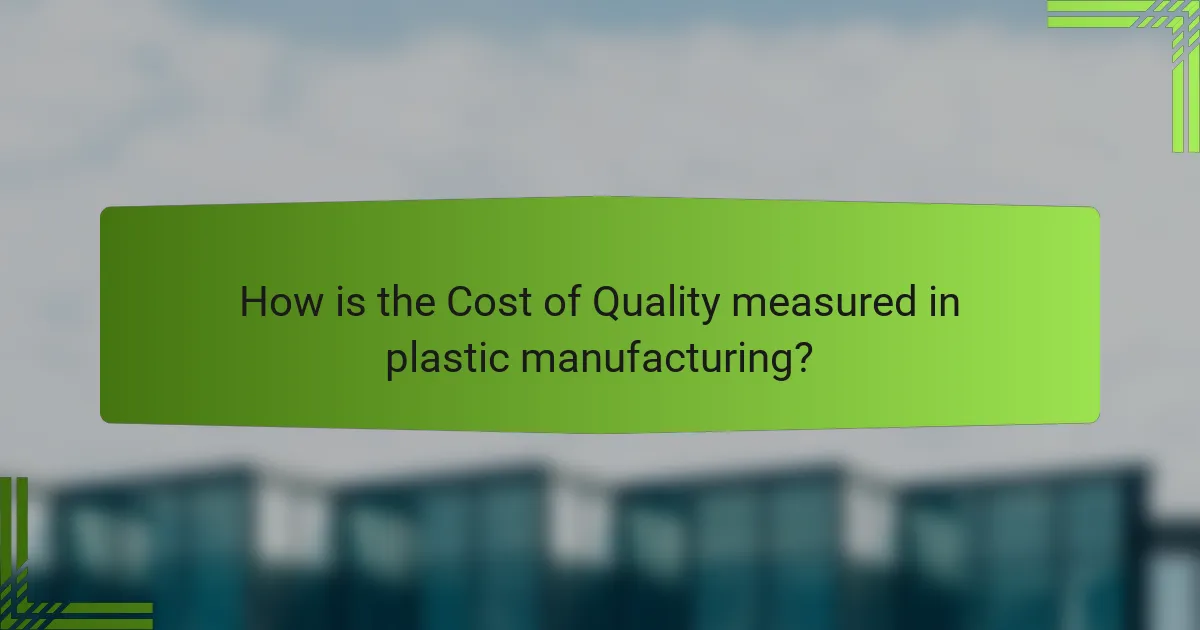
How is the Cost of Quality measured in plastic manufacturing?
The Cost of Quality in plastic manufacturing is measured by evaluating four key components: prevention costs, appraisal costs, internal failure costs, and external failure costs. Prevention costs include expenses related to quality planning and training. Appraisal costs cover the costs of inspection and testing of materials and products. Internal failure costs arise from defects found before delivery, such as scrap and rework. External failure costs occur when defects are discovered after delivery, leading to returns and warranty claims. Each of these components contributes to the overall cost of ensuring quality in plastic manufacturing processes. Accurate measurement helps identify areas for improvement and cost reduction.
What measurement techniques are commonly used in the industry?
Common measurement techniques used in the plastic manufacturing industry include dimensional measurement, weight measurement, and visual inspection. Dimensional measurement assesses the size and shape of plastic components using tools like calipers and micrometers. Weight measurement ensures that the mass of the products meets specifications, often using precision scales. Visual inspection involves examining the surface quality and finish of plastic parts for defects. These techniques are essential for maintaining quality standards and ensuring compliance with industry regulations. Each method contributes to identifying variations that could impact the cost of quality.
How do statistical process control methods apply to quality measurement?
Statistical process control (SPC) methods are essential for quality measurement in manufacturing. SPC utilizes statistical techniques to monitor and control processes. This ensures that the manufacturing process operates at its full potential. By analyzing variations in production, SPC helps identify areas needing improvement. Control charts are a primary tool in SPC, displaying process data over time. They indicate whether a process is stable or if corrective action is needed. Studies show that implementing SPC can reduce defects by up to 50%. This leads to significant cost savings in production. Overall, SPC methods enhance quality measurement by providing actionable insights into manufacturing processes.
What role do quality audits play in assessing the Cost of Quality?
Quality audits are essential for assessing the Cost of Quality. They systematically evaluate processes, products, and systems to identify areas of inefficiency. By uncovering defects and non-conformities, quality audits help quantify the costs associated with poor quality. This includes costs related to rework, scrap, and warranty claims. Furthermore, audits provide insights into compliance with quality standards and regulations. They also aid in identifying opportunities for process improvement. Data collected during audits can inform management decisions aimed at reducing overall quality costs. Ultimately, quality audits contribute to a clearer understanding of the financial impact of quality issues in plastic manufacturing.
What metrics can be utilized to evaluate the Cost of Quality?
Metrics to evaluate the Cost of Quality include the Cost of Prevention, Cost of Appraisal, and Cost of Failure. The Cost of Prevention refers to expenses incurred to prevent defects. This includes training, process control, and quality planning costs. The Cost of Appraisal encompasses costs associated with measuring and monitoring quality. This includes inspection, testing, and evaluation expenses. The Cost of Failure is divided into internal and external failure costs. Internal failure costs arise from defects found before delivery, while external failure costs occur when defects are discovered after delivery. These metrics provide a comprehensive view of quality-related expenses in manufacturing.
How is the cost of poor quality calculated?
The cost of poor quality is calculated by assessing the costs associated with defects and failures in products. This includes costs from rework, scrap, warranty claims, and lost sales. Companies often categorize these costs into internal failure costs and external failure costs. Internal failure costs arise from defects found before delivery. External failure costs occur when defects are discovered after delivery to customers.
Additionally, prevention and appraisal costs are factored in. Prevention costs are incurred to avoid defects, while appraisal costs are associated with measuring and monitoring the quality. This comprehensive approach ensures all aspects of quality costs are accounted for. Accurate calculation helps organizations identify areas for improvement and reduce overall costs.
What performance indicators are crucial for monitoring quality costs?
Crucial performance indicators for monitoring quality costs include the cost of prevention, cost of appraisal, cost of internal failure, and cost of external failure. The cost of prevention refers to expenses incurred to prevent defects. This includes training, process control, and quality planning. The cost of appraisal involves costs associated with measuring and monitoring activities. Examples are inspection and testing costs. The cost of internal failure is related to defects found before delivery. This includes rework and scrap costs. The cost of external failure arises when defects are found after delivery. This includes warranty claims and returns. Monitoring these indicators helps identify areas for improvement and reduce overall quality costs.

What strategies can be implemented to improve the Cost of Quality?
Implementing effective strategies to improve the Cost of Quality involves several key actions. First, organizations should invest in training employees on quality standards and practices. This can lead to fewer defects and rework, ultimately reducing costs. Second, adopting a robust quality management system helps in identifying and mitigating quality issues early in the production process. Third, utilizing statistical process control can monitor production processes in real-time, allowing for immediate corrective actions. Fourth, conducting regular audits and assessments ensures compliance with quality standards. Additionally, fostering a culture of continuous improvement encourages employees to identify and solve quality-related problems proactively. Lastly, engaging suppliers in quality initiatives enhances the overall quality of materials, reducing defects and costs associated with poor quality. These strategies collectively contribute to a more efficient production process and lower overall costs associated with quality failures.
How can organizations reduce prevention and appraisal costs?
Organizations can reduce prevention and appraisal costs by implementing efficient quality management systems. These systems streamline processes and minimize errors during production. Training employees on best practices enhances their skills and reduces mistakes. Regular audits identify inefficiencies, leading to cost-saving adjustments. Investing in technology automates inspections, lowering labor costs and increasing accuracy. Supplier quality management ensures materials meet standards, reducing the need for extensive appraisal. Continuous improvement programs foster a culture of quality, driving down costs over time. Research shows that organizations adopting these strategies can see up to a 30% reduction in quality-related costs.
What best practices can enhance quality assurance processes?
Implementing best practices such as standardized procedures can significantly enhance quality assurance processes. Standardized procedures ensure consistency in operations and reduce variability. Regular training for staff on these procedures is essential for maintaining high standards. Incorporating automated testing tools can improve efficiency and accuracy in quality checks. Conducting regular audits helps identify areas for improvement and compliance issues. Utilizing data analytics allows for better tracking of quality metrics over time. Engaging in continuous improvement initiatives fosters a culture of quality within the organization. These practices collectively contribute to reducing defects and improving overall product quality in plastic manufacturing.
How can employee training impact the Cost of Quality?
Employee training can significantly reduce the Cost of Quality by enhancing skills and knowledge. Improved employee competency leads to fewer errors in the manufacturing process. With better training, employees can identify and rectify issues before they escalate. This proactive approach minimizes waste and rework costs. According to a study by the American Society for Quality, organizations that invest in employee training experience up to a 50% reduction in defects. Enhanced training also fosters a culture of quality, encouraging employees to take ownership of their work. Ultimately, effective training translates to higher product quality and lower overall costs.
What role does technology play in improving quality costs?
Technology plays a crucial role in improving quality costs in plastic manufacturing. It enhances process efficiency and reduces waste. Automation minimizes human error, leading to higher consistency in product quality. Advanced data analytics allows for real-time monitoring of production processes. This enables quick identification of defects and corrective actions. Implementing quality management software streamlines documentation and compliance. According to a study by the American Society for Quality, organizations using technology to manage quality costs saw a 20% reduction in overall expenses. These improvements ultimately lead to increased customer satisfaction and loyalty.
How can automation and data analytics contribute to quality improvements?
Automation and data analytics can significantly enhance quality improvements in plastic manufacturing. Automation streamlines processes, reducing human error and increasing consistency. For instance, automated machinery can maintain precise tolerances, which is crucial in producing high-quality plastic components. Data analytics enables manufacturers to track performance metrics in real-time. This allows for immediate identification of quality issues and facilitates proactive adjustments. Research shows that companies using data analytics report a 10-20% reduction in defects. Furthermore, automation can speed up inspections through advanced imaging technologies. This ensures that any deviations from quality standards are detected swiftly. Overall, integrating automation and data analytics leads to enhanced efficiency and improved product quality in plastic manufacturing.
What are the benefits of adopting advanced manufacturing technologies?
Adopting advanced manufacturing technologies enhances efficiency and productivity in production processes. These technologies streamline operations, reducing waste and minimizing errors. Automation and robotics can increase production speed significantly. For instance, studies show that automation can improve output by up to 30%. Advanced manufacturing also allows for better quality control through real-time monitoring. This leads to a reduction in defects, which can save costs associated with rework and returns. Additionally, integrating technologies like 3D printing can enable rapid prototyping, shortening the development cycle. Overall, these benefits contribute to higher profitability and competitiveness in the market.
What are common challenges faced in managing the Cost of Quality?
Common challenges in managing the Cost of Quality include balancing quality with cost efficiency. Organizations often struggle to allocate resources effectively between prevention, appraisal, and failure costs. Limited understanding of quality metrics can lead to misinformed decisions. Resistance to change from employees can hinder quality improvement initiatives. Additionally, inadequate training can result in poor quality practices. These challenges can ultimately affect product consistency and customer satisfaction. A study by the American Society for Quality highlights that companies with poor quality management experience higher defect rates and increased rework costs.
How can organizations overcome resistance to quality initiatives?
Organizations can overcome resistance to quality initiatives by fostering a culture of engagement. This involves involving employees in the decision-making process. When employees feel valued, they are more likely to support initiatives. Providing training and resources also helps alleviate fears about change. Clear communication about the benefits of quality initiatives is essential. Sharing success stories can motivate employees by illustrating positive outcomes. Additionally, leadership should model commitment to quality practices. Research shows that organizations with strong leadership support see higher employee buy-in.
What strategies can be employed to address resource limitations?
Strategies to address resource limitations include optimizing processes, improving efficiency, and leveraging technology. Process optimization can reduce waste and enhance productivity. Efficiency improvements often involve training staff and refining workflows. Leveraging technology, such as automation, can streamline operations and reduce labor costs. Additionally, prioritizing resource allocation based on critical needs can maximize impact. Collaboration with suppliers may also provide access to shared resources. Implementing these strategies can lead to significant cost savings, as evidenced by companies that report up to a 30% reduction in operational costs through effective resource management.
What practical tips can help manage the Cost of Quality effectively?
Implementing a robust quality management system is essential to effectively manage the Cost of Quality. This system should include regular training for employees on quality standards. Training enhances awareness and reduces errors. Conducting frequent quality audits helps identify areas for improvement. These audits can reveal hidden costs associated with poor quality. Utilizing statistical process control (SPC) can monitor production processes in real-time. SPC allows for immediate corrective actions to prevent defects. Establishing a culture of continuous improvement encourages proactive quality management. Engaging employees in quality initiatives fosters accountability and ownership. Finally, investing in quality tools and technologies can streamline processes and reduce costs. These practices collectively contribute to lowering the overall Cost of Quality in plastic manufacturing.
The main entity of this article is the Cost of Quality in plastic manufacturing, which encompasses the total costs associated with ensuring that products meet quality standards, including prevention, appraisal, and failure costs. The article provides an in-depth analysis of the components of the Cost of Quality, measurement techniques used in the industry, and various strategies for improvement. Key topics include the significance of understanding quality costs, the impact on manufacturing efficiency, and practical tips for managing these costs effectively. Additionally, it highlights the role of technology and employee training in enhancing quality assurance processes.
